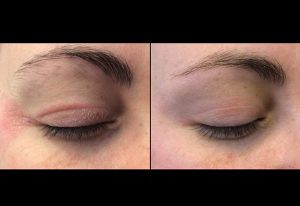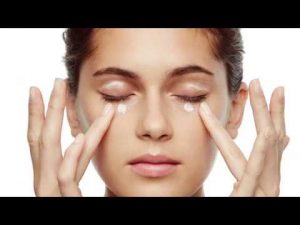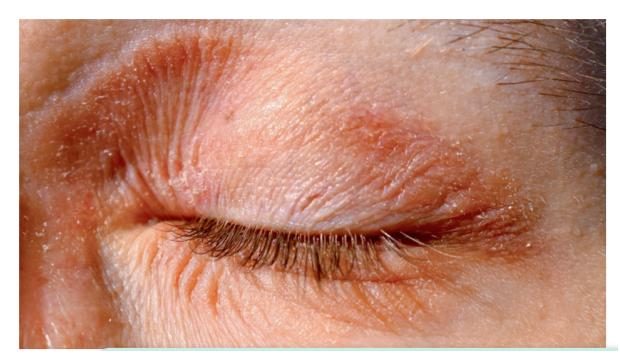Not only aging but there are many other factors causing wrinkles around the eyes like eczema. Dermatitis or Eczema is a skin condition characterized by dry, itchy patches of skin that are irritable and prone to blisters and flare-ups. Itchy, dry, rough, flaky, inflammatory, and irritated skin is common symptoms.
Atopic dermatitis manifests itself as red, inflammatory spots on the face, neck, and hands, but it may also be found behind the knees and inside the elbows. The skin may also appear brownish-gray and feel rough or scaly and is frequently broken as well.
Table of Contents
Go For Related Articles
Symptoms Of Eczema
Skin that is itchy, dry, rough, flakey, inflamed, and irritated is the main symptom of eczema. The condition can flare up, subside, and then flare up again. Even though it doesn’t cause wrinkles, it can make existing ones appear more prominent. As a result, regions of your skin that are not affected by illness may look brighter and smoother than inflamed spots.
When a skin region is repeatedly scratched or touched for an extended length of time, its cells begin to sprout.
Eczema causes skin thickness and amplification of typical skin markings such as cracks, wrinkles around eyes, or scales.
The Causes of Eczema
The causes of the complication are not fully known. However, one way to keep healthy and clear skin is to identify and avoid possible triggers.
A variety of triggers such as soaps and detergents, wool, infections, cold weather, dry skin, sweating, and emotional stress, as well as dust mites, pollen, molds, or foods, can trigger the disease.
Here is a detailed list of some potential triggers:
1. Food
- When you consume foods or ingredients that are inflammatory, you can experience a flare-up. Red meat, refined carbohydrates, sugar, and gluten are some examples.
- Foods you are allergic to might provoke an inflammatory reaction and aggravate your eczema symptoms.
- Don’t consume dairy products for several days or weeks if you notice flares after eating dairy products. Watch for improvements in your symptoms. You can gradually resume your dairy consumption if your symptoms improve.
2. Cold air
- Dermatitis can flare up in some people when temperatures are cooler.
- During the winter, too much dry air can stop natural moisturization. Itching is frequently caused by dryness, which subsequently leads to scratching and irritation.
3. Hot weather
- Complications can also be caused by hot weather. Itchy skin can result from heavy perspiration.
- Keep the temperature as low as possible to keep sweat to a minimum. To minimize overheating, drink lots of fluids, sit or stand in shaded locations, and use a fan.
4. Exposure to water
Water can also trigger migraines after prolonged exposure. Itching can be caused by water.
It can be avoided by:
- Applying moisturizer after bathing or swimming
- Avoiding drying out by taking lukewarm baths or showers
5. Stress and anxiety
Emotional stress can also trigger symptoms.
Cortisol is one hormone the body produces when it is under stress. Cortisol promotes inflammation throughout the body in high amounts, such as when coping with chronic and continuous stress. This can cause skin irritation and an eczema flare-up.
Following tips can help cope with stressful situations:
- Taking deep breaths
- Meditation
- Getting enough rest
- Exercising regularly
- Seeking therapy
6. Detergent
Washing detergents may cause problems for people with sensitive skin. The majority of the detergents have fragrances and chemicals as their ingredients that can irritate, causing itching, burning, and redness.
You should switch to a fragrance-free and sensitive-skin-friendly detergent if your symptoms appear to worsen after laundry day.
7. Scented products
Scented items applied to the body, such as laundry detergents, can aggravate the symptoms. Contact dermatitis, which occurs when a person comes into contact with a chemical, affects certain persons. Fragrant soaps, lotions, perfumes, shower gels, and other personal care products can irritate the skin and cause an allergic reaction.
To avoid this situation
- Make sure your body products are hypoallergenic and scent-free.
- After you start a new product, you should closely monitor your symptoms. In case they worsen, stop using it.
8. Fabrics
The fabric you wear sometimes causes a flare-up, not the detergent. Polyester and wool may cause itchiness and redness if you are sensitive to them.
To save yourself from this
- Try not to wear clothes that seem to worsen your condition.
- Protect your skin by wearing an additional layer under your garment.
9. Airborne allergens
Examples of airborne allergen are
- dust mites
- pollen
- pet dander
- mold
Keeping your home free of allergens requires regular cleaning, including dusting and vacuuming as well as washing your bedding every week. You should also consider installing hardwood floors instead of carpet.
10. Exercise
Heavy exercise can cause you to sweat a lot, aggravating your symptoms.
In case you suffer from flares after exercising, reduce the intensity of the workout or complete exercises at a time of day when it is cooler. Use a fan to cool off in the morning or the early afternoon.
11. Skin infections
Infections can lead to severe damage if left untreated, thus putting you at risk. Dermatitis flares can also be triggered by fungal, viral, or bacterial infections.
12. Hormonal changes
Changing hormones can also affect your eczema. It is caused by a drop in estrogen, which occurs during menopause, pregnancy, and just before a menstrual cycle.
This decrease causes a loss of moisturization. Your condition may worsen as a result.
Even though you may not be able to avoid it completely, discuss with your doctor your options for regulating your hormones. You should also moisturize more during this period.
13. Saliva
Since babies and children are prone to this condition, it is important to protect their delicate skin. Drooling babies can develop patches around their cheeks and chin.
The reason is not saliva or drooling, but it can dry up a baby’s skin and produce itchy, red patches. To keep this from happening, use baby-safe lotions or creams.
Treatment
Having atopic dermatitis can be a persistent problem. To control it, you may have to try several treatments for months or years. Signs and symptoms can come back even after treatment has been successful.
Identifying the issue as soon as possible allows you to start addressing it in the early stages. If frequent moisturizing and other self-care measures fail to relieve your symptoms, your doctor may recommend the following treatments:
Medications
Your doctor may prescribe the following medicine:
- corticosteroid cream or ointment.
- calcineurin inhibitors
- antibiotics
- Oral drugs
Calcineurin inhibitors
Your immune system is affected by inhibitors such as tacrolimus (Protopic) and pimecrolimus (Elidel).
When using these, keep the following things in mind:
- For people older than two years old, these creams are used to control reactions.
- After you moisturize, apply the cream as directed.
- If you’re using these products, stay out of direct sunlight.
- The black box warning for these drugs mentions the possibility of cancer.
As far as the cancer-causing problem is concerned, it has been concluded that the risk-to-benefit ratio of topical pimecrolimus and tacrolimus is similar to that of most other conventional treatments, and the data do not warrant the use of black box warnings.
Antibiotics
In the case of bacterial infections, open sores, or cracks, your doctor may prescribe an antibiotic cream. In the short term, he or she may suggest taking oral antibiotics.
Oral drugs that control inflammation
More severe cases are often treated with oral corticosteroids, such as prednisone. Although effective, these drugs should not be used for a long period due to possible serious side effects.
Newer Options
Dupilumab (Dupixent) is a new injectable biologic (monoclonal antibody) approved by the Food and Drug Administration (FDA). These methods are used for treating severe cases of the disease in which other treatments fail to alleviate the symptoms. We do not have long-term data to determine how well this medication helps. Despite that, studies have shown that using it as directed is safe. The product is very expensive.
Therapies:
Wet dressings
- Topical corticosteroids and wet bandages are applied to the affected area.
- Patients with widespread lesions frequently have this procedure done in a hospital due to the labor intensity and nursing expertise involved.
Light therapy
Patients who do not improve with topical treatments or relapse quickly after treatment may benefit from this treatment.
- In the simplest form of light therapy (phototherapy), the skin is exposed to controlled amounts of natural sunlight.
- Other forms of phototherapy use artificial ultraviolet light (UVA) or narrow-band ultraviolet light (UVB) with or without medications.
The effects of light therapy may be beneficial, but long-term use is harmful, such as accelerated skin aging and cancer risk. Due to these reasons, young children are rarely treated with phototherapy, and infants do not receive it.
Counseling:
Individuals who are frustrated or embarrassed by their condition can benefit from talking with a therapist or counselor.
The following approaches prescribed by a counselor may help
- Relaxation
- Behavior modification
- Biofeedback.
How Eczema affects The eyes

The eyelid is affected by contact dermatitis when it is exposed to substances that cause it to react. Contact dermatitis may result from irritation (irritant contact dermatitis) or allergy (allergic contact dermatitis).
Symptoms:
- Contact dermatitis can affect the upper or lower eyelids or both.
- A patient may experience itching, burning, or scaly lids, along with itching, burning, or stinging.
- They may swell.
- In the course of persistent dermatitis, the eyelids thicken with lichenification (increased scarring).
- The eyelid margins can become inflamed (blepharitis).
The thin eyelids are particularly susceptible to irritants and allergens, making contact dermatitis a possibility. A rash in different parts of the body may not be caused by the same trigger.
The following eye problems may result from atopic dermatitis:
- This condition can cause an inflammation of the cornea, called Keratitis.
- In patients with atopic dermatitis, spontaneous retinal detachment, when the retina separates from its supporting tissue, is more common.
- Very rarely, scarring can develop in various parts of the eye.
- Keratoconus, in which the cornea bulges outward, is also sometimes caused by this condition.
- Atopic dermatitis can also raise your chances of having cataracts, which are cloudy areas that grow within the normally clear lens of your eyes.
How does eczema cause wrinkles around the eyes
The sensitive areas around the eyes may be particularly vulnerable in this condition. There are small creases called Dennie-Morgan lines (DMs) that appear along your lower eyelids. Double folds of skin can develop beneath your eyes from these causes.
These lines, unlike wrinkles, are not linked to the normal aging process. DM lines, on the other hand, generally form in early childhood as a result of allergies and other immune system responses.
The creases under your eyes may be DM lines if you’ve ever had an allergic reaction or dermatitis.
Causes of Dennie-Morgan folds
Age Factor:
Age is one of the most important factors contributing to the appearance of wrinkles. The wrinkles induced by age may appear in the following areas:
- Crow’s feet which are found near the outer corners of your eyes
- The folds on either side of your mouth (nasolabial folds)
- The lines between your eyebrows (frown lines)
- near the top of your head (worry lines)
DM folds, however, are not the same as wrinkles that come with aging. Rather than resulting from a loss of elastin and collagen, these lines are a result of a genetic predisposition to allergies or dermatitis.
Genetics
In some cases, DM lines are linked to atopy, a genetic tendency to respond strongly to allergens.
It is possible to develop allergic diseases due to atopy. A parent with allergic disease, along with these wrinkles, places you at a higher risk for having them, as well.
Atopic dermatitis
The condition is extremely common in early childhood, affecting an estimated one out of five babies. Eczema is associated with inflammation caused by allergic diseases.
Although the condition may improve with age, you may still have the DM lines associated with it. In some cases, DM lines are just one of several diagnostic criteria for the disease.
Allergic rhinitis
Allergic rhinitis, often known as hay fever, has a significant connection to DM lines. When you are suffering from allergic rhinitis, your immune system mistakes innocuous chemicals for invaders, resulting in a slew of symptoms affecting various parts of your body, including your eyes, nose, ears, and throat.
A person with hay fever may have both wrinkles as well as dark circles under their eyes. These two undereye features could be caused by chronic nasal congestion caused by hay fever.
How to remove wrinkles around eyes causing by eczema
Dennie-Morgan fold treatment :
Lines formed by DM are often associated with allergic diseases during childhood. The wrinkles may, however, become more obvious with age.
The treatment of DM folds consists primarily of
- Addressing the underlying causes
- Some cosmetic treatments
Blepharoplasty
Blepharoplasty is a permanent procedure that may be recommended by a dermatologist for severe wrinkles and sagging. In this surgical procedure, excess sagginess under your eyes is removed to help smooth out lines and wrinkles.
Typical risks associated with blepharoplasty include:
- Bleeding
- Scarring
- Infections
Only the most severe cases of undereye wrinkles and sagging are candidates for this treatment. It’s not meant to be used on lines that are mild to moderate.
Allergy medications
A doctor may recommend medicines for allergic rhinitis
- Decongestant
- Antihistamine
- Shots may provide more lasting comfort from allergies
Allergic treatment won’t eliminate DM lines but will reduce inflammation and reduce allergic shiners.
Dermal fillers
The use of temporary substances like hyaluronic acid and collagen as fillers in areas where there are lines and wrinkles is known as dermal fillers.
Several months after the injections wear off, you’ll need follow-up treatments. Temporary swelling and bruising are possible side effects.
Topical creams
DM lines and inflammation may be reduced with eye wrinkle creams that contain vitamins C, hyaluronic acid, peptides, and ceramides.
For maximum benefit, you’ll need to use them daily. If you have eczema flare-ups under your eyes, keep away from under-eye creams containing alcohol and over-the-counter perfumes.
Dermal fillers
The use of temporary substances like hyaluronic acid and collagen as fillers in areas where there are lines and wrinkles is known as dermal fillers.
Several months after the injections wear off, you’ll need follow-up treatments. Temporary swelling and bruising are possible side effects.
Laser therapy
Laser therapy has also been studied as a possibility for treating allergic shiners and DM folds.
However, studies show that this treatment is not suitable for all patients. Some of the potential side effects include :
- Redness
- Chemical peels
- Hyperpigmentation
- Scarring
How are creams one of the best treatments to overcome eczema around the eyes?

It can be a challenge to find the right products to treat your eczema, but when flare-ups occur on fragile areas, like your eyelids, the situation gets even worse. To handle eczema problems, dermatologists or skin experts always give preference to creams.
The best eye cream for eczema around the eyes will contain moisture-locking ingredients like ceramides and hyaluronic acid to treat flaky patches without further irritating the skin. Doctor Debra Jaliman, M.D. explains that ceramides and hyaluronic acid work together to hydrate the skin around the eyes.
When you have red, itchy, or flaky skin, use an eye cream without fragrance, dyes, or other known allergens. To prevent bacteria and allergens from entering, choose products housed in airtight packaging to reduce itch severity.
Home remedies for eczema around the eyes
Bruising and fine lines under the eyes can be reduced by using certain skincare products and home remedies.
Facial Exercises
There is anecdotal evidence that certain facial exercises tighten the skin beneath your eyes. There’s no reason to assume these are dangerous, but the study on “facial yoga” is very limited.
Treat Allergies
Allergies can cause your eyes to become watery and swollen. Scratching or rubbing causes red eyes. You can achieve a more relaxed appearance on your face by treating allergy symptoms, and you can protect the region underneath your eyes as well.
Gently Exfoliate
If dryness appears under your eyes, you can gently exfoliate it to promote new cell growth. Use products that are specifically made for exfoliating and massaging under your eyes.
Moisturize with an eye cream
The best moisturizers are those that contain ingredients that promote the growth of new cells and circulation. Aside from retinol (derived from vitamin A), peptides and hyaluronic acid have all been supported by research and aestheticians. Vaseline is also a good moisturizer and serves the required purpose.
Other simple applications that you can use are:
- cucumber slices
- oatmeal and honey salve
- using cool milk-dipped washcloths
- aloe vera gel
Verdict
Eczema is a condition that can add to your worries and significantly affect your life if you start feeling uncomfortable about your body. Therefore, care must be taken by avoiding interaction with triggers. Additionally, consulting a doctor and taking one of the prescribed treatments will surely ring you with relief.
FAQs
Q1: Is eczema a contagious disease?
It is characterized by dry, itchy, and red skin (atopic dermatitis). It’s a common, non-contagious skin disease. With conditions like asthma and allergies, you’re at a higher risk. Treatments can help control symptoms, but there is no cure.
Q2: Can you use eczema cream on eyelids?
Because the eyelid skin is thin, only mild topical steroids (0.5 – 1% hydrocortisone) are recommended for eyelid eczema.
Q3: Can stress cause eczema?
Although emotional stress isn’t the cause of the condition, it can cause the symptoms. Under stress, the body releases a hormone called cortisol that increases inflammation throughout the body.




